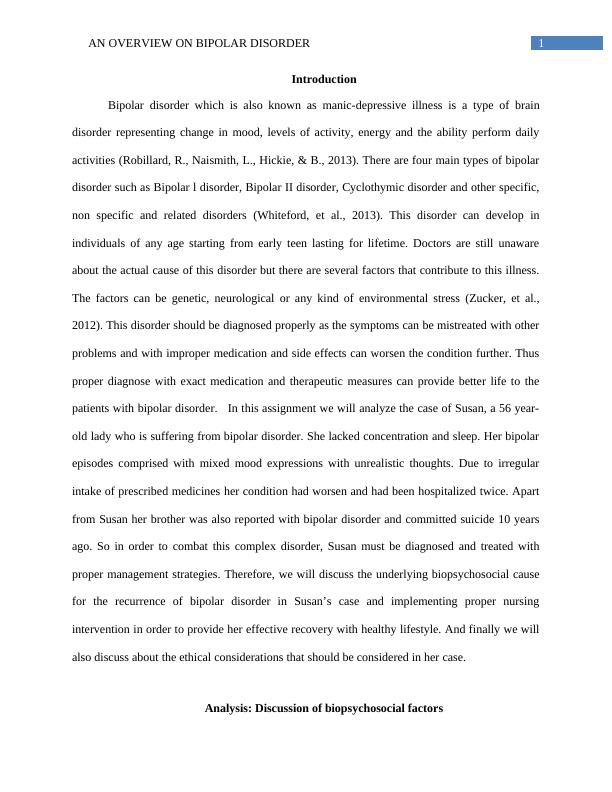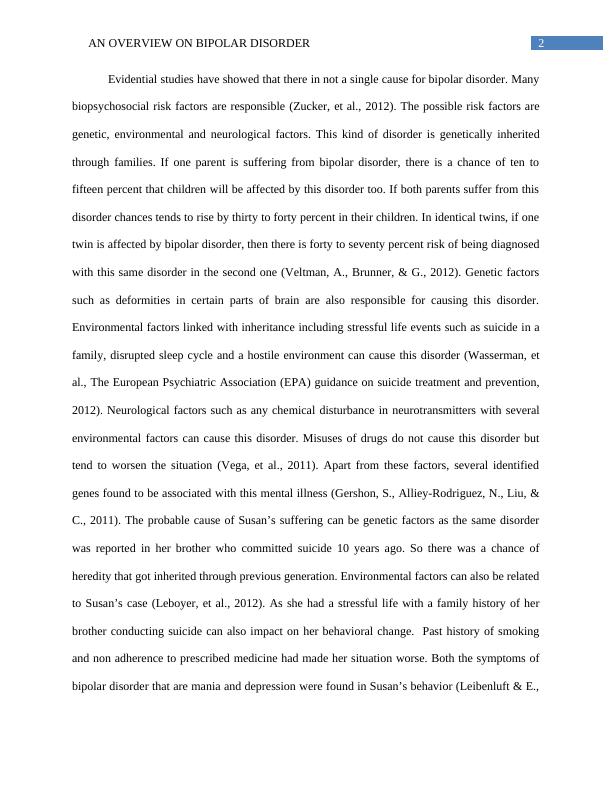Types of Bipolar Disorder : Assignment
12 Pages3512 Words81 Views
Added on 2020-02-24
Types of Bipolar Disorder : Assignment
Added on 2020-02-24
ShareRelated Documents
Running head: AN OVERVIEW ON BIPOLAR DISORDERAn overview on bipolar disorderName of the StudentName of the UniversityAuthor Note

1AN OVERVIEW ON BIPOLAR DISORDERIntroductionBipolar disorder which is also known as manic-depressive illness is a type of braindisorder representing change in mood, levels of activity, energy and the ability perform dailyactivities (Robillard, R., Naismith, L., Hickie, & B., 2013). There are four main types of bipolardisorder such as Bipolar l disorder, Bipolar II disorder, Cyclothymic disorder and other specific,non specific and related disorders (Whiteford, et al., 2013). This disorder can develop inindividuals of any age starting from early teen lasting for lifetime. Doctors are still unawareabout the actual cause of this disorder but there are several factors that contribute to this illness.The factors can be genetic, neurological or any kind of environmental stress (Zucker, et al.,2012). This disorder should be diagnosed properly as the symptoms can be mistreated with otherproblems and with improper medication and side effects can worsen the condition further. Thusproper diagnose with exact medication and therapeutic measures can provide better life to thepatients with bipolar disorder. In this assignment we will analyze the case of Susan, a 56 year-old lady who is suffering from bipolar disorder. She lacked concentration and sleep. Her bipolarepisodes comprised with mixed mood expressions with unrealistic thoughts. Due to irregularintake of prescribed medicines her condition had worsen and had been hospitalized twice. Apartfrom Susan her brother was also reported with bipolar disorder and committed suicide 10 yearsago. So in order to combat this complex disorder, Susan must be diagnosed and treated withproper management strategies. Therefore, we will discuss the underlying biopsychosocial causefor the recurrence of bipolar disorder in Susan’s case and implementing proper nursingintervention in order to provide her effective recovery with healthy lifestyle. And finally we willalso discuss about the ethical considerations that should be considered in her case. Analysis: Discussion of biopsychosocial factors

2AN OVERVIEW ON BIPOLAR DISORDEREvidential studies have showed that there in not a single cause for bipolar disorder. Manybiopsychosocial risk factors are responsible (Zucker, et al., 2012). The possible risk factors aregenetic, environmental and neurological factors. This kind of disorder is genetically inheritedthrough families. If one parent is suffering from bipolar disorder, there is a chance of ten tofifteen percent that children will be affected by this disorder too. If both parents suffer from thisdisorder chances tends to rise by thirty to forty percent in their children. In identical twins, if onetwin is affected by bipolar disorder, then there is forty to seventy percent risk of being diagnosedwith this same disorder in the second one (Veltman, A., Brunner, & G., 2012). Genetic factorssuch as deformities in certain parts of brain are also responsible for causing this disorder.Environmental factors linked with inheritance including stressful life events such as suicide in afamily, disrupted sleep cycle and a hostile environment can cause this disorder (Wasserman, etal., The European Psychiatric Association (EPA) guidance on suicide treatment and prevention,2012). Neurological factors such as any chemical disturbance in neurotransmitters with severalenvironmental factors can cause this disorder. Misuses of drugs do not cause this disorder buttend to worsen the situation (Vega, et al., 2011). Apart from these factors, several identifiedgenes found to be associated with this mental illness (Gershon, S., Alliey-Rodriguez, N., Liu, &C., 2011). The probable cause of Susan’s suffering can be genetic factors as the same disorderwas reported in her brother who committed suicide 10 years ago. So there was a chance ofheredity that got inherited through previous generation. Environmental factors can also be relatedto Susan’s case (Leboyer, et al., 2012). As she had a stressful life with a family history of herbrother conducting suicide can also impact on her behavioral change. Past history of smokingand non adherence to prescribed medicine had made her situation worse. Both the symptoms ofbipolar disorder that are mania and depression were found in Susan’s behavior (Leibenluft & E.,

3AN OVERVIEW ON BIPOLAR DISORDER2011). During the episode of mania, Susan developed a feeling of “high” with an increasedattitude with outgoing mood. She stopped her medication which was prescribed to her in herprevious admission to hospital. The behavioral changes noticed in Susan were making frequentcalls to her friends in the middle of the night and making animated conversations about planninga trip. She was even found risking her reputation by engaging in pleasant talks with maleneighbors. Depression is another symptom that was also prevalent in her followed by sometimeshigh and sometimes whilst in the middle of a “high” feeling (Kernberg, F., Yeomans, & E.,2013). In depression episode she slept for few hours. Other behavioral changes in Susan includedloss of concentration loss and problem in decision making that made her lose job. These episodesoccur at a regular interval lasting minimum for 2 years, in children for 1 year and in adults for 1year. Rapid cycling is caused in people with bipolar II disorder and people are found to be 35times more depressed than hypomania (Geddes, R., Miklowitz, & J., 2013). And the people withbipolar disorder undergo more time with an average episodes of 0.4-0.7 per year (Hanford, C.,Sassi, B., Hall, & B., 2016). In mixed episodes, patients suffer mania or hypomania anddepression and individuals might try to commit suicide to get rid of such symptoms.Analysis: Discussion of nursing management or interventionsSusan represented mixed episodes of bipolar disorder showing symptoms of mania anddepression. During mania she felt at top of the world with unrealistic and irrational plans. Sheeven started smoking in order to cope up the symptoms of bipolar disorder which she had quittedpreviously. She even lacked sleep with increased mood. During her maniac cycle she tends to

End of preview
Want to access all the pages? Upload your documents or become a member.
Related Documents
MENTAL HEALTH NURSING PRACTICE 2 Running Head: Mental Health Nursing Practice Descriptionlg...
|11
|2556
|34
Bio-Psychological Factors Contributing to Depression: Nursing Interventions and Ethical Implicationslg...
|9
|2829
|414
Therapeutic Communication and Management Strategies for Borderline Personality Disorderlg...
|11
|3307
|276
Depression: Symptoms, Causes and Factors Contributing to Depression in Adult Menlg...
|8
|2752
|339
Pharmacy Clinical Research Study Reportlg...
|13
|3455
|13
Dementia and Depression: Major Mental Health Issues in Australialg...
|8
|1109
|336
